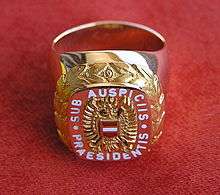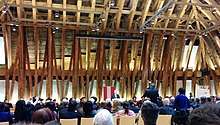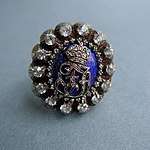Sub auspiciis Praesidentis
Promotio sub auspiciis Praesidentis rei publicae (lat. Doctoral graduation under the auspices of the Federal President), in Austria often abbreviated as sub auspiciis doctoral graduation (German Sub Auspiciis Promotion), refers to a special form of doctoral graduation which is the highest possible distinction for academic achievements in Austria.

Promotio sub auspiciis Imperatoris (Monarchy)
Awards comparable to the sub auspiciis graduation can be traced back to the foundation of universities at the end of the Middle Ages and can be found in verifiable “Promotiones sub auspiciis Imperatoris” (lat. Imperator = Emperor) since the first half of the 17th century.[1] The Promotio sub auspiciis Imperatoris is first mentioned in a document of the University of Graz, where under Emperor Ferdinand II the tribute was paid to a count in 1625. First presented in Vienna in 1661, this custom continued until the end of the Austro-Hungarian Empire. The Jesuits, to whom the University of Vienna was subordinated through the Sanctio pragmatica (1623-1773), seem to have contributed significantly to this development with the involvement of the court.
Until the middle of the 18th century, the honour was almost exclusively bestowed on sons of the high nobility, but already during the reign of Maria Theresa the regulations were relaxed. Of the graduations held under her, 31 (of a total of 53) were already bourgeois. The first woman, however, was not awarded a doctorate under the auspices of the Federal President until 1953 at the University of Vienna.
For the earliest period of this type of excellence doctorate, there is neither an imperial decree nor a university directive that makes the necessary conditions for being awarded a doctorate under the auspices of the emperor apparent. However, the sources do show that the same conditions had to be met from the very beginning of the award, which were later--as an important milestone--stipulated by a ministerial order of 28 August 1888, which listed as requirements not only the excellent performance at school and university, but also dignified conduct by the chosen candidate.[2]
The solemn ceremonial act has essentially been preserved since the 17th century. After the reception of the imperial representative, the seats were taken in compliance with a certain seating order and accompanied by the sounds of the marching fanfares. This was followed by the welcoming of the guests and a brief overview of the history of the award. Afterwards the Dean presented the candidate in front of the assembly, who bowed three times before the portrait of the Emperor and handed out his printed theses. Only then the actual disputation began. After this the candidate bowed again and was led to the emperor's representative who, after a speech, presented him with the imperial gift.[3]
Promotio sub auspiciis Praesidentis rei publicae (Austrian Second Republic)
More than 33 years after the collapse of the Austro-Hungarian Empire, on 5 March 1952, the Second Republic passed a Federal Law on the awarding of doctorates under the auspices of the Federal President, which is extremely concise.[4] The following persons are granted to receive their doctorate under the auspices of the Federal President[4]
- Has completed the upper classes of a secondary school with very good results,
- Has passed the Matura at a "secondary school" with distinction,
- Has completed the university studies in all subjects with the best examination result as defined in the applicable study regulations and has passed all the strict examinations (“Rigorosa”) required to obtain the doctorate with distinction,
- Has written a scientific paper (dissertation), if one is required, which was evaluated as excellent by the reviewers,
- The duration of studies may not exceed the average duration of studies, unless there are good reasons for a delay (e.g. work as a student trainee, illness and the like).
- Has proven to be worthy of distinction through his or her behaviour both at and outside the university.
Requirement according to today's school and study law
The Federal Law on the award of doctorates under the auspices of the Federal President was last amended in 1968, so it needs to be interpreted in the context of the school and study law in force today. The mandatory requirements for the sub-auspiicis doctorate according to today's view are[5]
- Excellence in all upper grades of a secondary school
- Matriculation examination (Matura) with distinction
- In the course of study "very good" grades in all partial examinations of the diploma, bachelor and master examinations as well as in the final examination (“Rigorosum”).
- Best marks for the scientific written papers (diploma or master thesis and dissertation)
The requirements are determined by the Senate of the University by notice and submitted to the Federal Ministry of Education, Science and Research and the Presidential Chancellery for approval. While conventional doctorates are only of a formal nature, sub auspiciis candidates may not hold the academic degree doctor) until after the sub auspiciis ceremony.
Ceremony

The PhD celebration itself is a special ceremony for the doctoral candidates and takes place in the presence of President of Austria (he may, however, send a representative, which in practice generally only happens in case of illness). The doctoral candidate is free to give a "speech on a scientific topic approved by the highest academic authority".
At the University of Vienna, the doctorate sub auspiciis Praesidentis traditionally takes place on dies academicus, the founding day of the university on 12 March.
After the actual doctoral graduation with the oath and pledge, the Federal President bestows the ring of honour with the inscription "sub auspiciis Praesidentis" on the candidate who has now been awarded the doctorate.
Ring of honor
Since 1820, a ring of honour bearing the name of the reigning monarch has been awarded as a gift of honour to all sub auspiciis graduates. Since March 1952, section 4 of the Federal Öaw on the award of doctorates under the auspices of the Federal President has stipulated that the Federal President awards all doctors who have received their doctorates under his auspices a ring of honour, the seal of which contains the federal coat of arms and the words "sub auspiciis Praesidentis". On the occasion of the 60th anniversary of the Federal Law in 2012, a redesign of the ring of honour was commissioned[6], which has been awarded since the end of 2013.
 The ring of honour in times of the Austro Hungarian Empire (ca. 1900). Golden ring with monogram of Emperor Franz Joseph under an imperial crown on blue enamel in an oval. Monogram and crown are surrounded by 28 smaller and 14 larger diamonds set in gold. On the left and right side each a crowned double-headed eagle with breastplate.
The ring of honour in times of the Austro Hungarian Empire (ca. 1900). Golden ring with monogram of Emperor Franz Joseph under an imperial crown on blue enamel in an oval. Monogram and crown are surrounded by 28 smaller and 14 larger diamonds set in gold. On the left and right side each a crowned double-headed eagle with breastplate. The ring of honour of the Second Republic until October 2013. Made from 14-carat gold and enamel by jeweller A. E. Köchert in Vienna.
The ring of honour of the Second Republic until October 2013. Made from 14-carat gold and enamel by jeweller A. E. Köchert in Vienna..jpg) The current ring of honour, awarded since October 2013. Made of white gold by A. E. Köchert in Vienna. Redesigned on the occasion of the 60th anniversary of the Federal Law on the sub auspiciis doctorate.
The current ring of honour, awarded since October 2013. Made of white gold by A. E. Köchert in Vienna. Redesigned on the occasion of the 60th anniversary of the Federal Law on the sub auspiciis doctorate.
Statistics
Currently, an average of about 20 students per year receive their doctorate "sub auspiciis" (out of a total of about 2500 doctoral students per year) in Austria. In the first 60 years since the passing of the Federal Law on the Award of Doctorates under the auspices of the Federal President on 5 March 1952, 1042 (296 women and 746 men) have been awarded the corresponding doctorates. [7] Since 1952, nine people have succeeded in obtaining doctorates in two subjects "sub auspiciis" each.[8][9][10]
| University | first award of a doctorate sub auspiciis | total | women | men |
|---|---|---|---|---|
| University of Vienna | 1953 | 373 | 119 | 254 |
| University of Graz | 1954 | 174 | 63 | 111 |
| University of Innsbruck | 1952 | 174 | 63 | 111 |
| University of Salzburg | 1968 | 80 | 29 | 51 |
| TU Wien | 1964 | 126 | 16 | 110 |
| Graz University of Technology | 1954 | 43 | 0 | 43 |
| University of Leoben | 1973 | 5 | 0 | 5 |
| University of Natural Resources and Life Sciences, Vienna | 2008 | 3 | 1 | 2 |
| Vienna University of Economics and Business | 1977 | 4 | 1 | 3 |
| University of Linz | 1972 | 38 | 5 | 33 |
| University of Klagenfurt | 1987 | 8 | 5 | 3 |
| Medical University of Vienna | 2004 | 5 | 3 | 2 |
| Medical University of Graz | 2004 | 7 | 4 | 3 |
| Medical University of Innsbruck | 2004 | 1 | 1 | 0 |
| University of Music and Performing Arts Vienna | 2004 | 1 | 0 | 1 |
| Mozarteum University Salzburg | 2007 | 1 | 1 | 0 |
| University of Applied Arts Vienna | 2011 | 1 | 1 | 0 |
| TOTAL | 1042 | 296 | 746 | |
| Totel | Women | Men | ||
|---|---|---|---|---|
| Dr. phil. | Doctor of humanities and cultural sciences, Doctor of philosophy | 498 | 172 | 326 |
| Dr. techn. | Doctor of technical sciences | 198 | 20 | 178 |
| Dr. med. univ. | Doctor of medicine and medical science | 161 | 64 | 97 |
| Dr. rer. nat | Doctor of natural sciences | 121 | 28 | 93 |
| Dr. iur. | Doctor of law | 22 | 1 | 21 |
| Dr. rer. soc. oec. | Doctor of social and economic sciences | 18 | 5 | 13 |
| Dr. theol. | Doctor of theology | 14 | 3 | 11 |
| Dr. mont. | Doctor of montanist sciences | 5 | 0 | 5 |
| Dr. nat. techn. | Doctor of natural resources and life sciences | 3 | 1 | 2 |
| Dr. phil. fac. theol. | Doctor of philosophy at the catholic theological faculty | 1 | 1 | 0 |
| Dr. scient. med. | Doctor of medical science | 1 | 1 | 0 |
| TOTAL | 1042 | 296 | 746 | |
Bekannte Sub-Auspiciis promovierte Persönlichkeiten
- Harald Buchinger (theologist)
- Helmut Denk (pharmacologist, former president of the Austrian Academy of Sciences)
- Heinz Engl (mathematician, rektor der University of Vienna)
- Hildegard Goss-Mayr (peace activist and writer, first woman to receive the doctorate sub auspiciis at a Viennese university in 1953)
- Victor Franz Hess (Nobel laureate in physics 1936, sub auspiciis Imperatoris 1906 under Emperor Franz Joseph)
- Lothar Höbelt (historian)
- Peter Husslein (gynaecologist)
- Lisa Kaltenegger (astronomer und astrophysicist)
- Markus Müller (pharmakologist, rector of the Medical University of Vienna)
- Harald Niederreiter (mathematician)
- Klaus Pekarek (manager and member of the board of Uniqa Österreich AG)
- Rudolf Taschner (mathematician)
Erwin Schrödinger and the sub auspiciis doctoral graduation
The Austrian physicist and Nobel laureate Erwin Schrödinger (Nobel Prize in Physics 1933) would have fulfilled all the requirements for the doctoral graduation sub auspiciis Imperatoris in 1910, but at the University of Vienna only three candidates per year were allowed to receive this honour.[5] Erwin Schrödinger would have been the fourth. He was awarded a doctorate in 1910, only four years after his Matura in July 1906,[12] without an honorary doctorate to become a doctor of philosophy.
Collegium sub auspiciis prasidentis promotorum
The Collegium sub auspiciis prasidentis promotorum[13] is a non-profit association founded in Vienna in 2016 with the aim of establishing a network of "sub auspiciis" graduates and using this network for the promotion of gifted students in Austria.
Literature
- Walter Brunner: Die Promotio sub auspiciis. 2., ergänzte Auflage. Bundesministerium für Wissenschaft und Forschung, Wien 1990, ISBN 3-85456-231-4.
- Bundesministerium für Wissenschaft und Forschung (Hrsg.): Im Zeichen der Ringe. 60 Jahre Promotion unter den Auspizien des Bundespräsidenten, Wien 2012 (mit namentlicher Auflistung der über 1000 sub auspiciis Promovierten im Zeitraum 20. Dezember 1952 bis 5. März 2012).
Weblinks
| Wikimedia Commons has media related to Promotio sub auspiciis Praesidentis rei publicae. |
- Bundesgesetz über die Verleihung des Doktorates unter den Auspizien des Bundespräsidenten (Statutory source)
- Bundesgesetz über die Verleihung eines Ehrenringes durch den Bundespräsidenten
References
- Margarethe Rath (1953), Die Promotionen und Disputationen sub auspiciis Imperatoris an der Universität Wien, Mitteilungen des österreichischen Staatsarchivs 6 (in German), Wien, p. 50
- Margarethe Rath (1953), Die Promotionen und Disputationen sub auspiciis Imperatoris an der Universität Wien, Mitteilungen des österreichischen Staatsarchivs 6 (in German), Wien, p. 69
- Margarethe Rath (1953), Die Promotionen und Disputationen sub auspiciis Imperatoris an der Universität Wien, Mitteilungen des österreichischen Staatsarchivs 6 (in German), Wien, p. 75
- "RIS – Verleihung des Doktorates unter den Auspizien des Bundespräsidenten – Bundesrecht konsolidiert, Fassung vom 22.07.2018". Retrieved 2018-07-22.
- Bundesministerium für Wissenschaft und Forschung, ed. (2012), Im Zeichen der Ringe – 60 Jahre Promotion unter den Auspizien des Bundespräsidenten (in German), Wien, p. 15
- "Festakt: 60 Jahre Sub-auspiciis-Promotion". www.diepresse.com. Retrieved 2018-07-22.
- "60 Jahre „Sub auspiciis"-Promotion – Karlheinz Töchterle: Lobens- und bemerkenswerte Leistungen". APA-OTS. 2012-03-06.
- "Zum zweiten Mal „sub auspiciis" promoviert – ooe.ORF.at". orf.at. 2012-03-12.
- "Student promovierte zum zweiten Mal in Innsbruck „sub-auspiciis"". Tiroler Tageszeitung online. 2014-10-20. Retrieved 2020-03-08.
- "Medizinerin schloss zweites Studium „sub auspiciis" ab". Tiroler Tageszeitung online. 2018-06-21. Retrieved 2020-03-05.
- Republik Österreich. "/Doktorgrade an öffentlichen Universitäten". Retrieved 2018-07-22.
- "Erwin Schrödinger - Biography - Curriculum Vitae". Retrieved 2018-07-23.}
- "Collegium Sub Auspiciis | Association for the organisation and association of "sub auspiciis" graduates". Retrieved 2018-07-22.